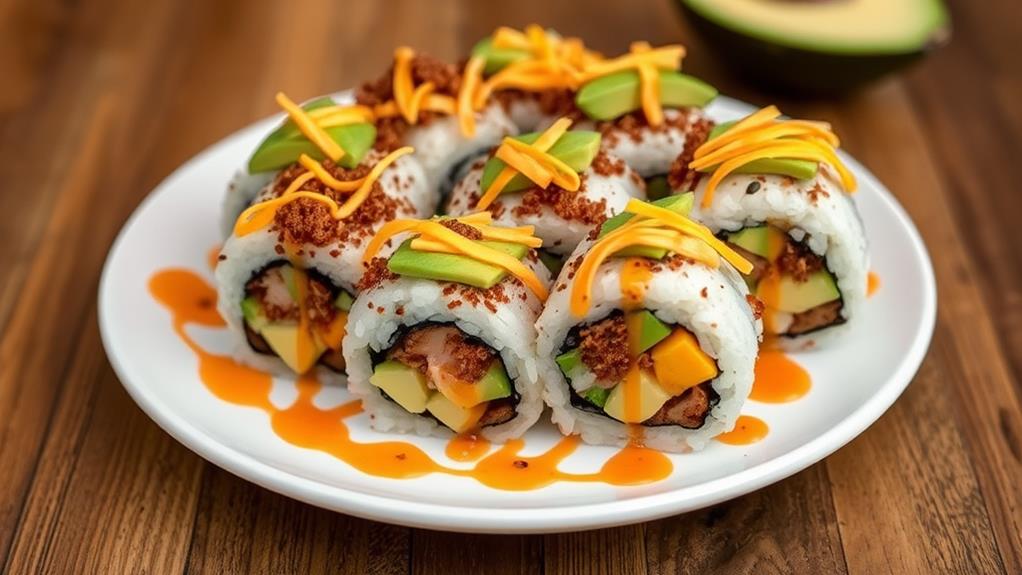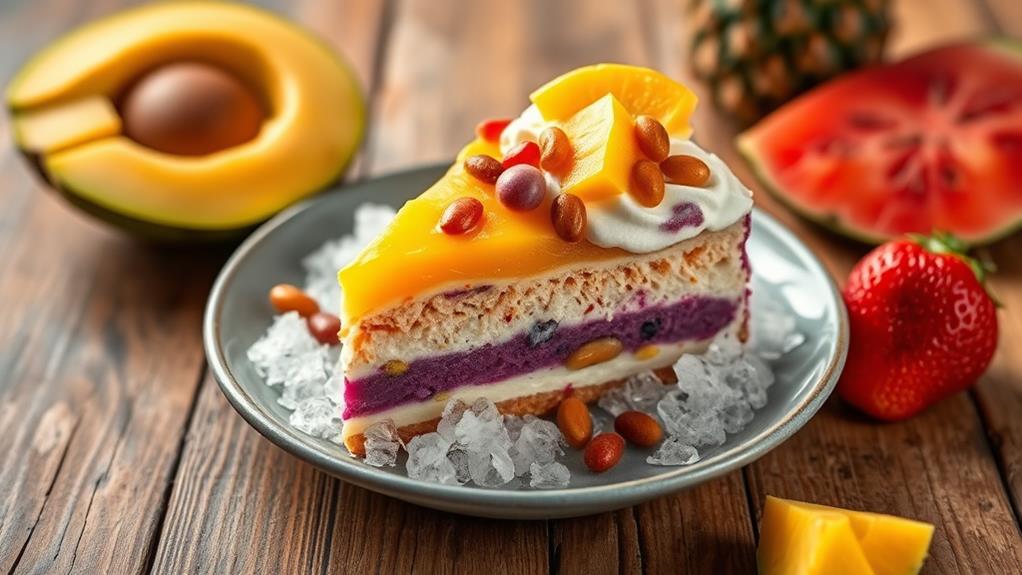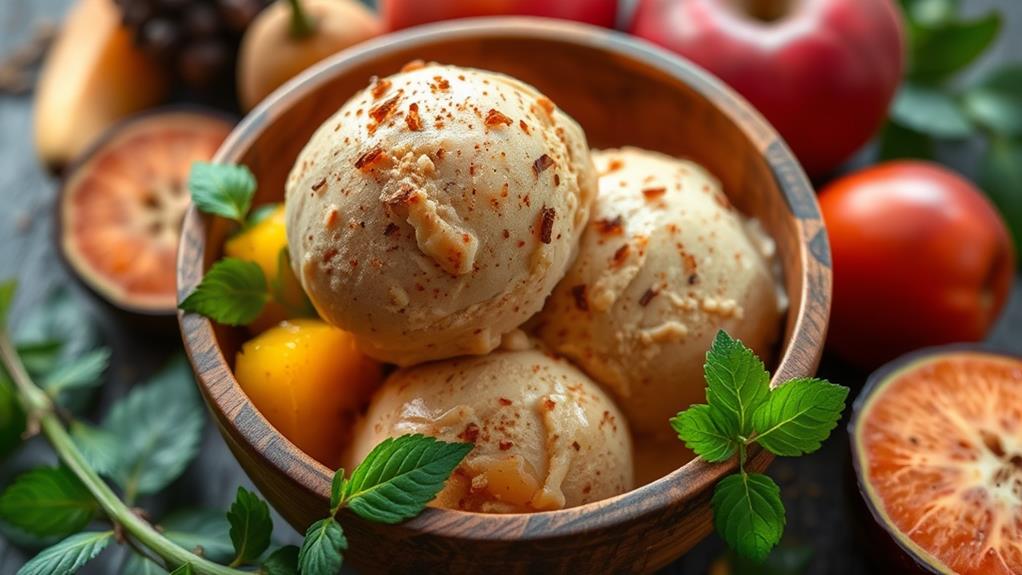The Philippines offers various unique food mashups. Five notable combinations include Lechon Kawali Sushi Roll, Ube Pancit Bihon, Halo-Halo Cheesecake, Chicharrón Nachos, and Adobo Flavored Ice Cream.
Lechon Kawali Sushi Roll is a fusion of crispy pork and sushi. This dish combines traditional Filipino lechon kawali with Japanese sushi, creating a distinctive flavor experience.
Ube Pancit Bihon combines vibrant purple yam with traditional Filipino noodles. This sweet and savory mashup showcases the versatility of ube in Filipino cuisine.
Halo-Halo Cheesecake is a creamy twist on the classic Filipino dessert. This dessert fusion combines the textures and flavors of halo-halo with cheesecake, creating a unique treat.
Chicharrón Nachos is a delicious fusion of crunchy pork and cheesy goodness. This dish combines the crispy texture of chicharrón with the creaminess of nachos, making it perfect for sharing.
Adobo Flavored Ice Cream blends savory and sweet flavors. This unique flavor combination showcases the versatility of adobo in Filipino cuisine, even in desserts.
Lechon Kawali Sushi Roll

Lechon Kawali Sushi Roll: A Fusion of Filipino and Japanese Cuisines
The Lechon Kawali Sushi Roll is a unique dish that combines the traditional Filipino lechon kawali, or crispy deep-fried pork belly, with Japanese sushi. This fusion dish wraps the lechon kawali in a sushi roll, creating a blend of flavors and textures.
The roll typically consists of succulent strips of lechon kawali, sushi rice, and nori, with added ingredients like fresh cucumber or creamy avocado for extra texture and freshness. The combination of crunchy and savory flavors makes for a delightful eating experience.
A dipping sauce combining soy sauce and vinegar is often served with the Lechon Kawali Sushi Roll. This sauce enhances the flavors of the lechon kawali while paying homage to both Filipino and Japanese culinary traditions.
The Lechon Kawali Sushi Roll showcases the versatility of Filipino cuisine, making it a popular choice in restaurants and food festivals.
This dish appeals to both sushi enthusiasts and adventurous eaters, offering a classic Filipino dish in a modern format.
Ube Pancit Bihon
Ube Pancit Bihon is a Filipino dish that combines the classic noodle dish Pancit Bihon with the vibrant ube purple yam.
Ube Pancit Bihon starts with the traditional Filipino noodle dish Pancit Bihon, which consists of thin rice noodles. This dish is elevated by the addition of ube, a purple yam known for its unique flavor and eye-catching color. The ube is used to create a creamy puree that's stir-fried with the noodles.
The dish includes a colorful medley of vegetables and the option to choose from chicken, shrimp, or pork as protein. A variety of vegetables are added to the dish, along with the chosen protein, to create a savory blend of textures and tastes. This blend isn't only satisfying but also visually stunning.
Ube Pancit Bihon is often served at celebrations like birthdays and family gatherings, embodying the Filipino custom of festive, colorful cuisine. In this dish, ube takes on a savory twist, appealing to both sweet and savory lovers alike. Additionally, the rich antioxidants and vitamins in ube add a nutritional boost to the meal.
Key to the dish is the unique flavor and nutritional value of ube. Ube is a purple yam that's typically reserved for desserts, but in Ube Pancit Bihon, it's used to create a savory twist. The addition of ube not only adds flavor but also provides a nutritional boost due to its rich antioxidants and vitamins.
Halo-Halo Cheesecake

Halo-Halo Cheesecake: A Refreshing Filipino Dessert Mashup
Halo-Halo Cheesecake is a unique dessert that combines the traditional Filipino dessert halo-halo with a creamy cheesecake. This fusion dessert blends the classic layers of crushed ice, sweet beans, and fruits with a rich cheesecake base, creating a treat that's both refreshing and satisfying.
A typical Halo-Halo Cheesecake features a graham cracker crust, providing a crunchy contrast to the soft cheesecake filling. The cheesecake is often topped with ube ice cream and smooth leche flan, mirroring the classic halo-halo presentation.
This creative twist allows you to experience the traditional flavors of halo-halo in a new way. Halo-Halo Cheesecake is a popular dessert in Filipino bakeries and dessert shops, especially during the warm summer months.
This dessert showcases the creativity of Filipino cuisine and appeals to both local and international palates, making it a must-try treat.
Chicharrón Nachos
Chicharrón Nachos: A Fusion of Flavors
Chicharrón Nachos combine the crispy, savory goodness of Filipino chicharrón with the cheesy indulgence of traditional nachos. This fusion dish creates an exciting experience for your taste buds, combining rich textures and flavors.
Key Components
To prepare Chicharrón Nachos, layer crispy chicharrón atop melted cheese, jalapeños, and other toppings. Tangy sauce is often drizzled on top for an extra kick.
Characteristics
- Texture: Crispy chicharrón layered with gooey cheese.
- Flavor: Savory and cheesy with a hint of spice.
- Serving Style: Perfect as a party appetizer or bar snack.
- Cultural Impact: A creative blend of Filipino cuisine and Tex-Mex.
Culinary Significance
Chicharrón Nachos showcase the innovative spirit of Filipino cuisine, blending traditional flavors with international influences.
This dish is ideal for parties and casual gatherings, offering a unique twist on classic nachos.
How Does Philippine Forest Cuisine Inspire Unique Food Mashups?
Philippine forest cuisine inspires unique food mashups by blending indigenous ingredients like rattan fruit, pandan, and wild ferns with global culinary techniques. This fusion creates dishes that are both rooted in tradition and driven by innovation, offering a taste of the Philippines’ lush biodiversity in every flavorful bite.
Adobo Flavored Ice Cream

Adobo flavored ice cream is a unique dessert that combines the savory taste of traditional Filipino adobo with the sweetness of ice cream. This innovative treat is made with ingredients like soy sauce, vinegar, garlic, and spices, which capture the essence of adobo. The combination of these ingredients with ice cream creates a refreshing and exciting dessert that's unlike traditional Filipino sweets.
The Philippines has seen a growing trend of culinary experimentation, which has led to the creation of adobo flavored ice cream. This trend is driven by adventurous eaters and foodies who are eager to try new takes on classic Filipino dishes. Adobo flavored ice cream can be found in specialty ice cream shops and at food festivals, where bold flavors are often featured.
Adobo flavored ice cream showcases the creativity of Filipino cuisine and its ability to reimagine traditional dishes in new ways. By combining the savory notes of adobo with the chill of ice cream, this dessert pushes the boundaries of culinary innovation.
This unique dessert is a testament to the rich culinary heritage of the Philippines and its ability to experiment with new flavors and ingredients.
Questions and Answers
What Is the Most Unique Food in the Philippines?
The most unique foods in the Philippines reflect its rich culinary history.
Filipino delicacies like balut and sisig showcase regional specialties, traditional ingredients, and cultural influences. balut, for instance, is a popular street food that combines a developing duck embryo with a flavorful broth and spices. sisig, on the other hand, is a festive dish that originated in the province of Pampanga, consisting of chopped pork's face, served with a sizzling plate and a squeeze of calamansi. These dishes are often found in vibrant local markets.
What Are 5 Unique Dishes in Philippine Cuisine?
Philippine cuisine offers a diverse range of unique dishes. Adobo variations showcase the adaptability of this classic dish, with different regions incorporating local flavors and ingredients. For example, chicken or beef can be used in place of pork, while alternative marinades like soy sauce or vinegar create distinct flavor profiles.
Another example of creative fusion is sinigang, a sour soup that combines tamarind broth with various vegetables and proteins. Some variations incorporate unique ingredients, such as guava or watermelon, to create a one-of-a-kind flavor experience.
Lechon tacos and lumpia burgers demonstrate the influence of foreign cuisines on Filipino dishes. These innovative fusion dishes blend traditional flavors with international cooking techniques, resulting in exciting and flavorful meals.
Lastly, Filipino desserts have also undergone creative transformations. Halo halo cheesecake and bibingka pancakes showcase the versatility of classic Filipino treats. These modern twists on beloved desserts blend familiar flavors with new textures and presentation styles, offering a fresh take on traditional sweets.
What Are the Exotic Foods in the Philippines?
Exotic Foods in the Philippines
The Philippines offers a diverse array of exotic foods that cater to adventurous eaters. Street food is a significant part of the country's culinary scene, with regional delicacies showcasing unique flavor profiles.
In the Philippines, you can find exotic ingredients such as balut (fertilized duck eggs), sisig (a dish made from chopped pig's face), and kamaru (fried crickets). These ingredients are often incorporated into traditional dishes that blend cultural influences from Spanish, Chinese, and Malay cuisines.
Examples of Exotic Foods
- Balut: a popular street food in the Philippines, balut is a developing duck embryo boiled and eaten from the shell.
- Sisig: a dish originating from the province of Pampanga, sisig is made from chopped pig's face, served with a sizzling plate and a squeeze of calamansi (Filipino lime).
- Kamaru: a delicacy in the province of Pampanga, kamaru is a dish made from fried crickets, often seasoned with salt and vinegar.
Culinary Traditions and Festivals
The Philippines celebrates various festivals that showcase its rich culinary traditions. One example is the MassKara Festival in Bacolod City, which features a street food festival with exotic delicacies such as grilled frogs and pigs' ears.
Sustainable Practices
Many Filipino farmers and food producers are adopting sustainable practices, such as farm-to-table methods, to promote environmentally friendly food production. This approach not only supports local communities but also ensures the freshness and quality of exotic ingredients.
What Is Philippines Most Popular Food?
The Philippines' most popular foods include Adobo, Sinigang, Lechon, Halo-Halo, Pancit, and Kare-Kare. These dishes are staples in the country's cuisine and vary in ingredients and cooking styles.
The Philippines' most popular food often features Adobo, a dish that can be made with chicken, pork, beef, or seafood. Adobo variations can be found across different regions, with each region adding its unique twist to the traditional recipe.
Another popular dish is Sinigang, a sour soup that can be made with pork, beef, chicken, or seafood. The key ingredient in Sinigang is a sour broth made from tamarind, guava, or mango.
Lechon, a whole roasted pig, is also a staple in Filipino cuisine. It is often served during special occasions and is known for its crispy skin and tender meat.
In addition to savory dishes, the Philippines is also known for its desserts, such as Halo-Halo. Halo-Halo is a mix of shaved ice, sweetened beans, fruits, and milk, topped with a scoop of ice cream.
Pancit, a noodle dish, is also a favorite among Filipinos. Pancit can be made with different types of noodles and can be served as a snack or a meal.
Lastly, Kare-Kare, a peanut-based stew, is a popular dish in the Philippines. It is made with ox tripe, vegetables, and ground rice, and is often served with steamed rice.